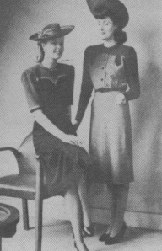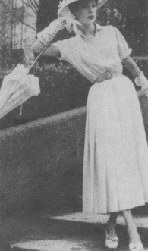Women's Fashion in early Johannesburg (1800's - 1900's) Page 5

During the abnormal period of World War II fashion trends, like most others phases of life, were sharply influenced by the cataclysm of war. Manufactureres of tailored costumes were limited to 50 different designs annually, each with a prescribed amount of material which no outfit could exceed. Tailored suits which seemed set to become a permanent wartime uniform were berefit of lapels, pockets, and multiple pleats.
Material shortages kept the hem just below the knee, and fortunate indeed was the woman who acquired for herself nylon seamless stockings which were guaranteed not to ladder. It became common practice for women to turn up to work without stockings or with legs painted in the colour of stockings, when paint was available.
Clothing factories, which in pre-war days battled to survive against competition from imported clothes, were now able to supply all South Africa's civilians as well as military needs. (The black-out warden who patrolled the dimmend- out streets of Durban usually wore a uniform made in the same Reef city where the uniform worn by the women in the auxiliary services were also manufactured.)
Though fashion stood still from the day South Africa declared war on 6 September 1939 until VJ day six years later, there were inconspicuous changes taking place all the time. The hemline, some 40cm from the floor in 1939, crept to 45cm during the following year and stayed there until war's end.
Neckerchiefs, which formed such an indispensable part of woman's wardrobe in 1939, were consigned to mothballs the following year and have remained there ever since. Even high-heeled shoes gave way to platform or low-heeled shoes in 1941.
Wartime hairstyles such as the page-boy bob or the Edwardian sweep remained in vogue until 1947. Many women replaced hats with a turban which they wore in the style of Mediterranean peasants. The only concession to fashion during those hard years was the padded shoulder.
The jackets of all service women's jackets were padded, as were those of civilian tailored jackets and coats. For the duration of the war shoulders remained much wider than hips.
After the war skirts lenghthened slightly, but it took a Paris designer, Christian Dior, to design a revolutionary New Look with a hemline only 20cm from the floor. While day dresses lengthened, evening dresses shortened. Every curve of the female body was accentuated.
Miss 1948's was totally unrelated to the 1046 -7 form. In a few post-war months Dame Fashion had undergone a complete metamorphosis, which in pre-war days would taken at least five years.


Images. Left: Wartime outfit of the 1940's were devoid of any trimmings and the padded, broadshouldered jackets favoured the woman with the more athletic figure. Right: Three years after the war hems dropped sharply; padding dissapeared from women's shoulders and every curve of the female body was accentuated.
With the New Look came new habits. Women ceased to don evening wear at twilight. The same hat became adequate for any and every accasion. It ceased to be a compulsive habit to dress for every occasion.In 1948 wide skirt and skin-hugging blouse became the norm, though skirt lenghts slowly shortened during the 1950's. The A and H lines were short-lived phases, but the sack line of 1957 determined women's shape for many years.
By 1965 the hemline once again reached the 1927 kneehigh lenght, but instead of retrating continued its upward climb. The invention of the mini-skirt altered women's own ideas about feminine modesty as nurses, metermaids, and air hostesses vied with one another to display the most chic mini-uniform.
In its heyday during the early 1970's it seemed as though every female from 16 to 60 favoured the miniskirt, with a hem some 50cm from the floor. Long after their European parents and American cousins had discarded the mini, South African women clung to it as though it had become the national uniform, ideally suited to a climate as hot and dry as ours.
In 1973 hems once again plunged floorwards and reached their lowest in 60 years, but a female more rebellious than her grandmother of 1914 had evolved. Her attitude to fashion had so altered that she no longer bowed to the desigher's dictates. Instead of wearing skirts the woman of the 1970's had an array of shorts, slacks, pyjama suits, and trousers from which to choose.
Hats which formed such an indispensable part of every woman's pre-war wardrobe have all but ceased to function as a fashion accessory.
Some say that fashion designers have exhausted the gamut of possible shapes into which the female form can be encased. Others maintain that the high price of manufactured clothes has turned woman away from fashion to such an extent that she can today be fashionable by dressing unfashionably.
Fashion historians often claim that the modern woman emerged with World War I; others claim that she arrived with the 1929 depression; while others insist that she is a product of World War II, but all will agree that the fashionably dressed female vanished before the start of the 1980's